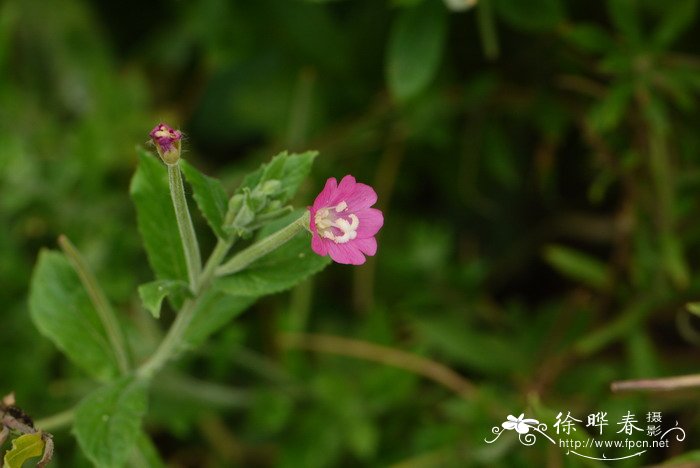柳叶菜 Epilobium hirsutum
中文名(Chinese Name):柳叶菜
学名(Scientific Name):Epilobium hirsutum L.
英文名(English Common Name):codlins and cream
别名(Chinese Common Name):鸡脚参
异名(Synonym):Chamaenerion hirsutum (L.) Scop. Epilobium hirsutum var. laetum Wall. ex C. B. Clarke Epilobium hirsutum var. sericeum Benth. ex C. B. Clarke Epilobium hirsutum var. tomentosum (Vent.) Boiss, Fl. Orient. Epilobium hirsutum var. villosum (Thunb.) H. Hara Chamaenerion grandiflorum (Weber) Moench Epilobium amplexicaule Lam. Epilobium aquaticum Thuill. Epilobium himalense Royle Epilobium hirsutum f. alboroseum D.C.McClint. Epilobium hirsutum f. minor Gancev Epilobium hirsutum f. minus Gancev Epilobium hirsutum var. villosissimum W.D.J.Koch Epilobium mirei Quézel Epilobium nassirelinulci Stapf Epilobium serratum Jacquem. ex C.B.Clarke
科属(Family & Genus):柳叶菜科(Onagraceae)柳叶菜属
形态特征(Description):多年生粗壮草本,有时近基部木质化,在秋季自根颈常平卧生出长可达1米多粗壮 地下葡匐根状茎,茎上疏生鳞片状叶,先端常生莲座状叶芽。茎高25-120(-250) 厘米,粗3-12(-22)毫米,常在中上部多分枝,周围密被伸展长柔毛,常混生较短而直的腺毛,尤花序上如此,稀密被白色绵毛。叶草质,对生,茎上部的互生,无柄,并多少抱茎;茎生叶披针状椭圆形至狭倒卵形或椭圆形,稀狭披针形,长4-12(-20)厘米,宽0.3-3.5(-5)厘米,先端锐尖至渐尖,基部近楔形,边缘每侧具20-50枚细锯齿,两面被长柔毛,有时在背面混生短腺毛,稀背面密被绵毛或近无毛,侧脉常不明显,每侧7-9条。总状花序直立;苞片叶状。花直立,花蕾卵状长圆形,长4.5-9毫米,径2.5-5毫米;子房灰绿色至紫色,长2-5厘米,密被长柔毛与短腺毛,有时主要被腺毛,稀被绵毛并无腺毛;花梗长0.3-1.5厘米;花管长1.3-2毫米,径2-3毫米,在喉部有一圈长白毛;萼片长圆状线形,长6-12毫米,宽1-2毫米,背面隆起成龙骨状,被毛如子房上的;花瓣常玫瑰红色,或粉红、紫红色,宽倒心形,长9-20毫米,宽7-15毫米,先端凹缺,深1-2毫米;花药乳黄色,长圆形,长1.5-2.5毫米,宽长0.6-1毫米;花丝外轮的长5-10毫米,内轮的长3-6毫米;花柱直立,长5-12毫米,白色或粉红色,无毛,稀疏生长柔毛;柱头白色,4深裂,裂片长圆形,长2-3.5毫米,初时直立,彼此合生,开放时展开,不久下弯,外面无毛或有稀疏的毛,长稍高过雄蕊。蒴果长2.5-9厘米,被毛同子房上的;果梗长0.5-2厘米。种子倒卵状,长0.8-1.2毫米,径0.35-0.6毫米,顶端具很短的喙,深褐色,表面具粗乳突;种缨长7-10毫米,黄褐色或灰白色,易脱落。花期6-8月,果期7-9月。染色体数n=18。
分布(Distribution):广布于我国温带与热带省区,生于海拔150-3500米河谷、溪流河床沙地或石砾地或沟边、湖边向阳湿处。广布于欧亚大陆与非洲温带。
用途(Use):
嫩苗嫩叶可作色拉凉菜;根或全草入药,可消炎止痛、祛风除湿、跌打损伤,活血止血、生肌之效。
引自中国植物志英文版:FOC Vol. 13 Page 412, 414
1. Epilobium hirsutum Linnaeus, Sp. Pl. 1: 347. 1753.
柳叶菜 liu ye cai | Onagraceae | Epilobium
Chamaenerion hirsutum (Linnaeus) Scopoli; Epilobium hirsutum var. laetum Wallich ex C. B. Clarke; E. hirsutum var. sericeum Bentham ex C. B. Clarke; E. hirsutum var. tomentosum (Ventenat) Boissier; E. hirsutum var. villosum (Thunberg) H. Hara; E. tomentosum Ventenat; E. velutinum Nevski (1937), nom. illeg. superfl., not H. Léveillé (1916); E. villosum Thunberg.
Herbs robust, perennial, sometimes woody near base with long, thick, ropelike hypogeal stolons often terminating in a rosette of leaves. Stems 25-120(-250) cm tall, much branched in upper half, densely villous pubescent, with short glandular hairs especially on inflorescence, rarely sparsely pubescent, or rarely densely white tomentose. Leaves sessile and clasping stem; cauline blade lanceolate-elliptic to narrowly obovate or elliptic, rarely very narrowly lanceolate, 4-12(-23) × 0.3-4(-5) cm, both surfaces villous, very rarely glabrescent, base subcuneate and clasping, margin serrulate with 20-50 teeth per side, apex acute to acuminate. Inflorescence and flowers erect. Sepals 6-12 mm, often keeled. Petals bright pink to dark purple, 8-20 mm. Stigma deeply 4-lobed. Capsules 2.5-9 cm, pubescent or rarely glabrescent; pedicels 0.5-2 cm. Seeds dark brown, 0.8-1.2 mm, coarsely papillose, with inconspicuous chalazal collar; coma tawny or dull white, detaching easily. Fl. Jun-Aug, fr. Jul-Sep. 2n = 36.
Wet places near streams, ditches, marshes, gravel or sandy beds of rivers, roadsides; (200-)500-2000 m in N China, (100-)500-2800(-3500) m in SW China. Anhui, Gansu, Guangdong, Guizhou, Hebei, Henan, Hubei, Hunan, Jiangsu, Jiangxi, Jilin, Liaoning, Nei Mongol, Ningxia, Shaanxi, Shandong, Shanxi, Sichuan, Xinjiang, Xizang, Yunnan, Zhejiang [Afghanistan, India, Japan, Korea, Mongolia, Nepal, Pakistan, Russia; widespread in Africa, SW Asia, Europe, and naturalized in North America].
This is an extremely widespread and variable species that spreads aggressively by vegetative growth in wet habitats.
Populations from Xinjiang tend to have strikingly tomentose pubescence, unlike plants from other regions, but the pattern of variability for entire species obscures these differences, so no subdivision is recognized.

 (责任编辑:徐晔春)
(责任编辑:徐晔春)
学名(Scientific Name):Epilobium hirsutum L.
英文名(English Common Name):codlins and cream
别名(Chinese Common Name):鸡脚参
异名(Synonym):Chamaenerion hirsutum (L.) Scop. Epilobium hirsutum var. laetum Wall. ex C. B. Clarke Epilobium hirsutum var. sericeum Benth. ex C. B. Clarke Epilobium hirsutum var. tomentosum (Vent.) Boiss, Fl. Orient. Epilobium hirsutum var. villosum (Thunb.) H. Hara Chamaenerion grandiflorum (Weber) Moench Epilobium amplexicaule Lam. Epilobium aquaticum Thuill. Epilobium himalense Royle Epilobium hirsutum f. alboroseum D.C.McClint. Epilobium hirsutum f. minor Gancev Epilobium hirsutum f. minus Gancev Epilobium hirsutum var. villosissimum W.D.J.Koch Epilobium mirei Quézel Epilobium nassirelinulci Stapf Epilobium serratum Jacquem. ex C.B.Clarke
科属(Family & Genus):柳叶菜科(Onagraceae)柳叶菜属
形态特征(Description):多年生粗壮草本,有时近基部木质化,在秋季自根颈常平卧生出长可达1米多粗壮 地下葡匐根状茎,茎上疏生鳞片状叶,先端常生莲座状叶芽。茎高25-120(-250) 厘米,粗3-12(-22)毫米,常在中上部多分枝,周围密被伸展长柔毛,常混生较短而直的腺毛,尤花序上如此,稀密被白色绵毛。叶草质,对生,茎上部的互生,无柄,并多少抱茎;茎生叶披针状椭圆形至狭倒卵形或椭圆形,稀狭披针形,长4-12(-20)厘米,宽0.3-3.5(-5)厘米,先端锐尖至渐尖,基部近楔形,边缘每侧具20-50枚细锯齿,两面被长柔毛,有时在背面混生短腺毛,稀背面密被绵毛或近无毛,侧脉常不明显,每侧7-9条。总状花序直立;苞片叶状。花直立,花蕾卵状长圆形,长4.5-9毫米,径2.5-5毫米;子房灰绿色至紫色,长2-5厘米,密被长柔毛与短腺毛,有时主要被腺毛,稀被绵毛并无腺毛;花梗长0.3-1.5厘米;花管长1.3-2毫米,径2-3毫米,在喉部有一圈长白毛;萼片长圆状线形,长6-12毫米,宽1-2毫米,背面隆起成龙骨状,被毛如子房上的;花瓣常玫瑰红色,或粉红、紫红色,宽倒心形,长9-20毫米,宽7-15毫米,先端凹缺,深1-2毫米;花药乳黄色,长圆形,长1.5-2.5毫米,宽长0.6-1毫米;花丝外轮的长5-10毫米,内轮的长3-6毫米;花柱直立,长5-12毫米,白色或粉红色,无毛,稀疏生长柔毛;柱头白色,4深裂,裂片长圆形,长2-3.5毫米,初时直立,彼此合生,开放时展开,不久下弯,外面无毛或有稀疏的毛,长稍高过雄蕊。蒴果长2.5-9厘米,被毛同子房上的;果梗长0.5-2厘米。种子倒卵状,长0.8-1.2毫米,径0.35-0.6毫米,顶端具很短的喙,深褐色,表面具粗乳突;种缨长7-10毫米,黄褐色或灰白色,易脱落。花期6-8月,果期7-9月。染色体数n=18。
分布(Distribution):广布于我国温带与热带省区,生于海拔150-3500米河谷、溪流河床沙地或石砾地或沟边、湖边向阳湿处。广布于欧亚大陆与非洲温带。
用途(Use):
嫩苗嫩叶可作色拉凉菜;根或全草入药,可消炎止痛、祛风除湿、跌打损伤,活血止血、生肌之效。
引自中国植物志英文版:FOC Vol. 13 Page 412, 414
1. Epilobium hirsutum Linnaeus, Sp. Pl. 1: 347. 1753.
柳叶菜 liu ye cai | Onagraceae | Epilobium
Chamaenerion hirsutum (Linnaeus) Scopoli; Epilobium hirsutum var. laetum Wallich ex C. B. Clarke; E. hirsutum var. sericeum Bentham ex C. B. Clarke; E. hirsutum var. tomentosum (Ventenat) Boissier; E. hirsutum var. villosum (Thunberg) H. Hara; E. tomentosum Ventenat; E. velutinum Nevski (1937), nom. illeg. superfl., not H. Léveillé (1916); E. villosum Thunberg.
Herbs robust, perennial, sometimes woody near base with long, thick, ropelike hypogeal stolons often terminating in a rosette of leaves. Stems 25-120(-250) cm tall, much branched in upper half, densely villous pubescent, with short glandular hairs especially on inflorescence, rarely sparsely pubescent, or rarely densely white tomentose. Leaves sessile and clasping stem; cauline blade lanceolate-elliptic to narrowly obovate or elliptic, rarely very narrowly lanceolate, 4-12(-23) × 0.3-4(-5) cm, both surfaces villous, very rarely glabrescent, base subcuneate and clasping, margin serrulate with 20-50 teeth per side, apex acute to acuminate. Inflorescence and flowers erect. Sepals 6-12 mm, often keeled. Petals bright pink to dark purple, 8-20 mm. Stigma deeply 4-lobed. Capsules 2.5-9 cm, pubescent or rarely glabrescent; pedicels 0.5-2 cm. Seeds dark brown, 0.8-1.2 mm, coarsely papillose, with inconspicuous chalazal collar; coma tawny or dull white, detaching easily. Fl. Jun-Aug, fr. Jul-Sep. 2n = 36.
Wet places near streams, ditches, marshes, gravel or sandy beds of rivers, roadsides; (200-)500-2000 m in N China, (100-)500-2800(-3500) m in SW China. Anhui, Gansu, Guangdong, Guizhou, Hebei, Henan, Hubei, Hunan, Jiangsu, Jiangxi, Jilin, Liaoning, Nei Mongol, Ningxia, Shaanxi, Shandong, Shanxi, Sichuan, Xinjiang, Xizang, Yunnan, Zhejiang [Afghanistan, India, Japan, Korea, Mongolia, Nepal, Pakistan, Russia; widespread in Africa, SW Asia, Europe, and naturalized in North America].
This is an extremely widespread and variable species that spreads aggressively by vegetative growth in wet habitats.
Populations from Xinjiang tend to have strikingly tomentose pubescence, unlike plants from other regions, but the pattern of variability for entire species obscures these differences, so no subdivision is recognized.
踩一下[0]

顶一下[0]